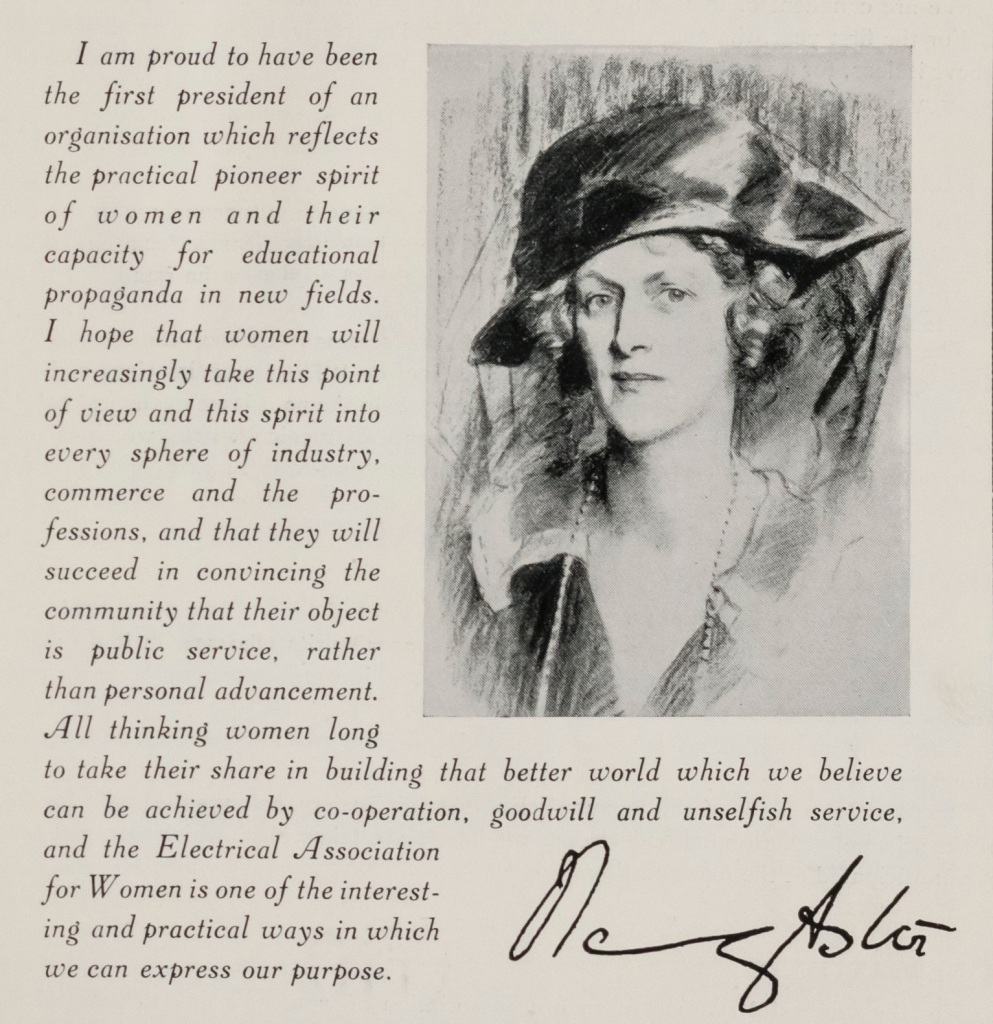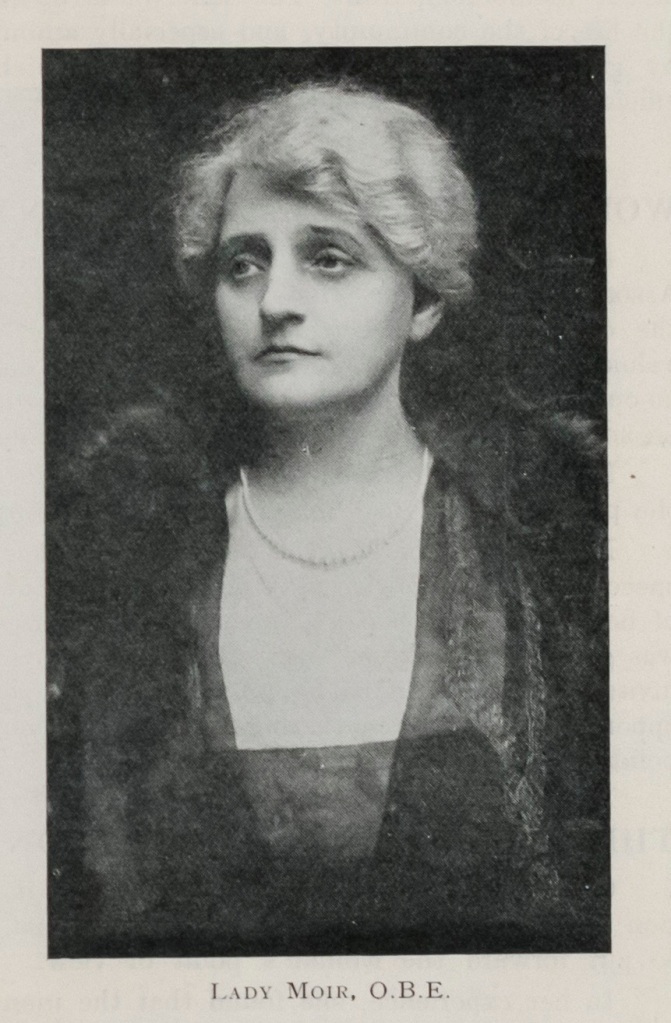Guest blog by Madeleine Smith, University of Leeds
This is the first of a series of blogs written by Liberal Arts students at the University of Leeds to celebrate the centenary of the Electrical Association for Women (EAW) in 2024. The students’ blogs on early EAW activities are based on themes selected from reading digitised versions of the first two volumes (1926-1935) of The Electrical Age (for Women). This project has been supported by Professor Graeme Gooday. You can discover more about the history of the EAW from the IET Archives.
Introduction
The first volume of the EAW journal The Electrical Age for Women (NAEST 093/09/01/01) covers June 1926 to April 1930. Over this time the EAW saw two Presidents; Lady Astor as the first President of the organisation followed by Mrs Wilfrid Ashley. As Presidents, both women were the public figureheads of the EAW and would have been chosen due to their upper-class notability. This blog post will explore their stints as Presidents as well as their life outside the EAW. Furthermore, I will delve a little into some of the big names mentioned on the introduction pages of the journals from Vol.1 such as Lady Moir and The Dowager Lady Swaythling as both women were Vice Presidents in this period and later became Presidents.
Nancy Astor, Viscountess Astor (1924-1928)
Viscountess Astor was the first President of the EAW. The first issue of the Electrical Association of Women journal in June 1926 features Nancy Astor as President of the organisation at the beginning of the journal. Lady Astor was referred to as Nancy Astor throughout her time with the EAW, which is unusual as it played down the normal, formal etiquette. She states how proud she is to have been elected as the first President of “an organisation which reflects the practical pioneer spirit of women and their capacity for educational propaganda in new fields.” (Vol.1, No.1). Astor expresses her goal for women to become increasingly more involved within the industry and be able to share their ambition with others as an act of public service.
In issue No.5 of the journal there is an extract showcasing ‘A Glimpse of the E.A.W Luncheon at the Hotel Cecil’ where Astor presented a characteristic speech. She remembers the issues the women who started the organisation suffered and compares this to their success they had at the time. Astor described that she “sent a warm feeling into her heart when she saw what the women had done” (Vol.1, No.5) while also examining how views have changed from always relating to women to being in the house and only in the house. Nancy Astor finished her speech by stating how proud she was of what the association has achieved so far and was excited to see what was to come.
Viscountess Nancy Astor M.P was President of the EAW until 1928. Her life outside of the association was equally as exciting. Nancy Astor made history in 1919 by becoming the first woman to take her seat in the British House of Commons. She won a by-election in Plymouth Sutton, succeeding her husband, Waldorf Astor, who had vacated the seat to take up a position in the House of Lords. Moreover, Astor was a vocal advocate for women’s rights and played a crucial role in advancing issues related to women’s suffrage and equality. Her presence in Parliament helped pave the way for future generations of women in British politics.
Muriel Ashley, Lady Mount Temple (1881-1954)
Muriel Ashley, also known as Molly Mountemple, is referred to in the EAW Journal by her second married name of Mrs Wilfrid Ashley. Wilfrid Ashley became the first Baron Mount Temple in 1935.
Muriel Ashley’s first introduction in the Electrical Association of Women journals was in the July 1928 No.9 issue. She had been mentioned prior in the journals, the first time being in the first issue of the journal when she welcomes the magazine. However, further along she is mainly mentioned alongside her husband who was the Minister of Transport. Her introductory page in the journal states that being the “wife of the Minister of Transport, we have every reason to believe that she took a very active interest in the passage of the Electricity (Supply) Act, 1926.” (Vol.1, No.9). She was particularly interested in social issues, education, and healthcare. Her philanthropic efforts included support for hospitals and initiatives aimed at improving living conditions for the less fortunate. The piece discusses her extracurriculars such as her interest in charity work and being involved in local communities to raise money for needy and worthy objects. Furthermore, the piece explains her other career ventures; her work within the National Society for the Prevention of Cruelty to Children as well as the National Orthopaedic Hospital.
Outside of her mentions in the EAW journal, Mrs Wilfrid Ashley was described as a keen interior decorator and alongside her husband she employed architect Oliver Hill to design two Westminster houses for them both. However, some sources showed her in a negative light stating that when she married her husband who was the Minister of Transport, she became an ‘unsavoury’ and cruel stepmother to his children.
However, according to the EAW journals, Mrs Wilfrid Ashley was an extremely appropriate choice as second President of the association. Her presidency ran from 1928-1931 and she was advertised as having an interest “in all matters electrical” as described by the journal’s editor. (Vol.1, No.9).
Margaret, Lady Moir (1864-1942)
Margaret, Lady Moir is mentioned at the beginning of the July 1927 EAW journal. She had a successful career not only as an engineer alongside her husband and a lathe operator during the First World War, but she also had boundless impact in the world of women engineers. Lady Moir had a lot of involvement in the Electrical Association of Women as President of the EAW in 1931. Lady Moir was already a prominent figurehead in the industry not only for her ties to her husband but because she was a founder of the Women’s Engineering Society in 1919 and then one of the founders of the EAW in 1924.
In 1927 she was featured at the beginning of one of the Electrical Association of Women’s quarterly journals. Lady Moir advertised electricity to working class women running households while stating that they should realise the benefits of electricity and how it can immediately simplify household tasks. I love the use of a very persuasive statement saying that “the day soon comes when we can use it freely without having to think of these costly units”. This immediately makes readers want to read the journal after such a positive first page. Lady Moir had a lot of influence due to her money, her husband’s influence and her title therefore the use of announcing statements such as the one above would have had serious sway with readers. She fully believed that the dawn of the all-electric era was at hand.
“It is essential that women become electrically minded. By this I mean that they must not only familiarise themselves with electric washing machines, fires and cookers, but possess sufficient technical knowledge to enable them to repair fuses and make other minor adjustments. Only by doing so will women learn to value electricity’s cheapness and utility and regard it as a power to rescue them from all unnecessary household labours.”
Lady Moir, A Vision of the Home of the Future (Morning Post 11 July 1931)
Gladys, Baroness Swaythling (1879-1965)
Lady Swaythling is featured at the beginning of the January 1929 journal in Vol.1 discussing her many opinions on the importance of the Electrical Association of Women. In her opening statement she focuses immediately on her own wish of wanting others to be interested in electricity. Moreover, Lady Swaythling touches on the need for and objectives of the Electrical Association for Women; “formed with the object of interesting and instructing the women of the country on the subject.” (Vol.1, No.11). Finally, she explains how she wants the Electrical Association of Women to have the availability to open branches all over the country.
The Dowager Lady Swaythling joined the Electrical Association for Women after her husband died in 1927. She was a part of the organisation for three decades, acting as treasurer from 1931-1938 and then as President from 1938-1957.
Outside of the EAW Lady Swaythling was known for her philanthropy and awarded several honours during her life. She was appointed Dame of Grace, Most Venerable Order of the Hospital of St. John of Jerusalem and given an OBE. Swaythling was also a Fellow of both the Royal Geographical Society and the Royal Photographic Society. All these notable works show how much of a busy, important woman she was with all her many social and charitable roles apart from the EAW.
People featured in the EAW Journal 1926-1930
June 1926 – Nancy Astor – first EAW President
October 1926 – Mrs Wilfrid Ashley – EAW Vice-President (later President)
January 1927 – Lady Snell
April 1927 – Dame Henrietta Barnett DBE
June 1927 – Lady Moir – EAW President 1931-1935
October 1927 – The Viscountess Elibank
January 1928 – Lady Pearl Montagu of Beaulieu
April 1928 – H.R.H the Duchess of York
July 1928 – Colonel R E Crompton – first man to be featured at the front of the journal
October 1928 – Mrs Cadbury
January 1929 – The Dowager Lady Swaythling
April 1929 – Mrs Phillip Snowden
June 1929 – The Right Hon Margaret Bondfield
October 1929 – Mrs Llewelyn B Atkinson – treasurer of the EAW
January 1930 – Mrs J M Phillips – President of East Devon branch
April 1930 – The late Dr S Z de Ferranti
About the author
My name is Madeleine Smith and I am a second-year undergraduate student studying Liberal Arts (majoring in Sociology) at the University of Leeds. I am currently living in Leeds while studying my degree, however I am originally from a very small town in West Wales. I have loved studying the EAW and, having had very little prior information surrounding the organisation, I am continuing to find it fascinating how much information the Electrical Age journals hold and how many of the amazing women motioned have little recognition outside of the EAW journals.



